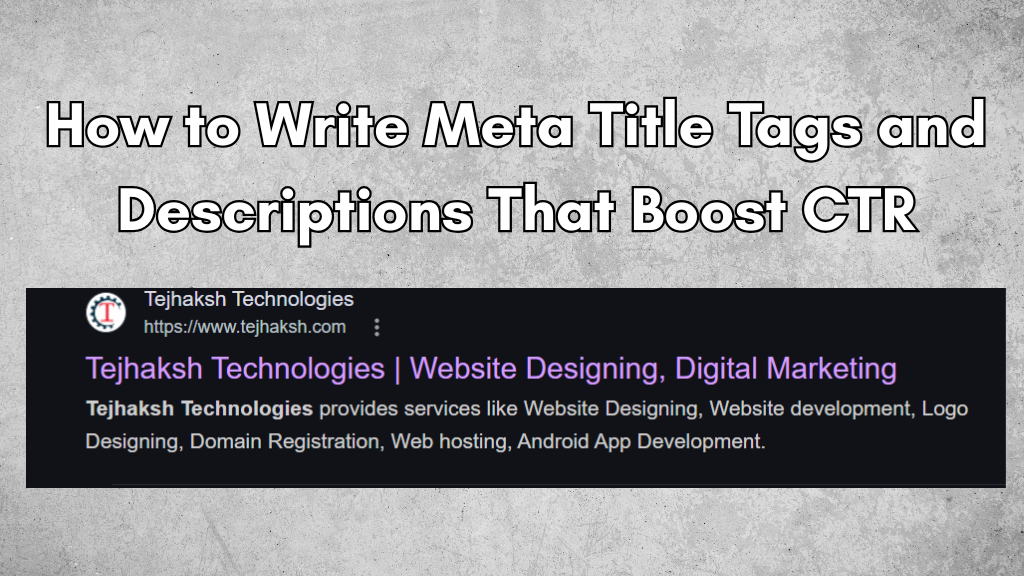


Tejhaksh Technologies is the Website designing & Digital Marketing company based in Neemuch, established in 2020 providing Website design, Website development, Logo design, Domain Registration, Web hosting, Android App Development, eCommerce web development, Search Engine Optimization, Bulk SMS etc. We have good experience in developing different platform websites and we keep our eye on the latest technologies to implement on the website for better conversion and user experience.

Meta titles and descriptions, also known as SEO titles and meta descriptions. In SEO and digital marketing, the meta title and meta description are two key parts that are often ignored but very important. These aren’t just technical SEO elements—they’re your first impression in search results. A well-written and well-formulated meta title and description can increase your click-through rate (CTR), drive more visitors to your site, and even improve your Google rankings.
Here, we’ll learn:
What is a meta title tag?
What is a meta description?
Why they matter for SEO and CTR.
How to write effective title tags.
How to create good meta descriptions.
Common mistakes to avoid.
Tools to help you improve your meta titles and descriptions.
Let us discuss all this in detail step by step.
The meta title tag is also known as the SEO title. Its use is important for SEO (Search Engine Optimization), it is the headline that helps search engines understand the subject of a webpage. It appears in search engine results pages (SERPs), usually in blue, as a clickable link. It helps both users and search engines understand the subject of the page.
Example:
Meta title:
How to Make a Chocolate Cake – Easy Recipe for Beginners
Where it appears:
It appears in Google search results.
Shows in browser tabs.
Appears on social media previews.
Optimal length:
Keeping it to 50–60 characters (including spaces) or less makes it fully display in search engine results.
Meta description is a small paragraph of a webpage, which is 150-160 characters. Whenever you search for any type of topic, the description is written in small text below the title and link. Its purpose is to provide the user with a concise information about the page’s content and encourage the user to click.
Example:
Meta Description:
Learn how to make a soft, moist chocolate cake with this simple, step-by-step recipe that’s perfect for beginners.
Best length:
A short paragraph of 150-160 characters
Meta titles and descriptions are very important for improving CTR (click-through rate). Things that entice users to click on your webpage during a search. Meta titles and descriptions act like an ad copy – they help users decide whether to click on your link or skip it.
Why are they important:
The meta title tag gives search engines information about a webpage. Follow these easy steps to write a strong meta title that gets more clicks.
1. Include Your Focus Keyword
The beginning of the title should include the main keyword related to the page content. This tells Google what your page is about.
Example:
2. Keep It Under 60 Characters
Long titles get cut off in search results. Keep titles between 50-60 characters for best visibility.
3. Be Clear, Not Clever
The title tag should clearly state what you have created the page about.
4. Use Numbers or Powerful Words
People are more likely to be attracted to numbers and emotional words like “best,” “easy,” “step-by-step,” “proven,” so use those words.
Example:
5. Add Your Brand Name (Optional)
If your brand is famous, be sure to add it at the end.
Example:
Meta description is a short and complete summary that tells us what our webpage is about. Meta descriptions do not directly affect rankings, but a good description greatly affects CTR.
1. Include Focus Keywords
Search engines bold similar keywords, which draws the user’s attention.
Example:
2. Use Action Words
Start with verbs: Use words like learn, discover, try, grow, get, get.
3. Respond to the Searcher’s Intent
Think: what is the user looking for? Include words that match their intent in your description.
4. Mention Benefits
What value does your web page provide? State or mention them clearly.
Example:
5. Include a Call to Action (CTA)
Use phrases like these in the web page description:
Read more
Try it now
Learn the secret
Learn how
Good Meta Title:
How to write a blog in 2025 – a step-by-step guide for beginners
Bad Meta Title:
Start Blogging
Good Meta Description:
Follow this beginner-friendly guide to start a blog in 2025. Learn how to choose the right platform, write effective posts, and grow your audience.
Bad Meta Description:
This blog is all about starting a blog.
If you want to make meta titles and descriptions good and effective, these tools can help you:
Google Search Console can be used to check the CTR of your pages
1. Digital Marketing Tips
Meta title: Digital Marketing Tips 2025 – The Easy Way
Meta description: Learn the latest digital marketing tricks of 2025 and how to buy your BIGGER online.
2. Weight Loss 1
Meta title: 7-Day Weight Loss Plan – Exercise and Ease
Meta description: Lose weight the safest way with this 7-day easy and inclusive tips.
3. Resume Writing
Meta title: Resume Writing Tips 2025 – The Way to Get a Job
Meta description: Learn how to create a professional resume that lands the interview. With easy tips and guides.
4. Cooking Blog (Paneer Recipe)
Meta title: Paneer Butter Masala Recipe – Taste Like It Is
Meta description: Make Kharij Cherry Butter Masala in easy steps – Restaurant-like taste now at home.
Creating or writing a good meta title tag and meta description isn’t just for SEO — it’s also important for connecting with your audience and driving users to your site. Think of it as the headline and pitch that will make someone click on your content instead of others.
By following the tips here, you can increase your page’s CTR (click-through rate), drive more organic traffic, and help your website grow.
Leave a Comment